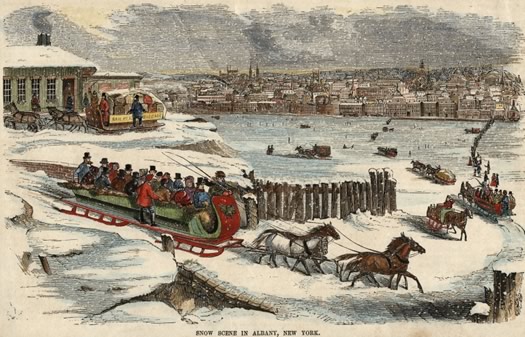Winter on the Hudson, a long time ago
We got a question today from a reader who, curious because of this winter's deep freeze, wanted to know if there are any officially sanctioned places or events for safely walking across the frozen Hudson River. After a bit of research and asking around, we arrived at the same conclusion she did: no, there are not. So, let's make this clear: Do not ever try to walk across the frozen Hudson -- not here, not upriver, not anywhere.
But, in looking into this topic, we came across some interesting local frozen Hudson River history. That image above is titled "Snow scene in Albany, New York". It's a hand-colored wood engraving on paper, part of the Albany Institute's collection, from around 1850 -- when things, including the river itself, were different.
Are those carriages? On the frozen Hudson? Yes, yes they are. From Hudson River Panorama: A Passage Through Time:
Ice formed regularly on the upper portions of the Hudson River until the 1903s, when deep channels were dredged for the year-round operation of the Port of Albany. A frozen river provided many opportunities to cross from one side to another. Numermous references to people walking or skating across survive, but horse-drawn sleighs provided one of the fastest and most common crossing methods. The popular Albany Sleigh, manufactured by James Goold and Company, was well known throughout the United States and Europe. According to the an 1871-72 brochure, Goold used only the finest wood and steel in his Albany Sleigh, which featured pleasing combinations of colorful paint decorations and included the finest plush upholstery and carpets for interiors. Established in 1813, Goold's company also manufactured carriages, coaches, and wagons.
So not only were people conveyed across the frozen Hudson River in a sleigh -- they were doing it in style. (Here's more on the Albany Sleigh over at Hoxsie.)
Bonus history bit: The frozen Hudson River also plays a role in "The Knox Expedition," a Revolutionary War story.
The expedition was an epic schlep of artillery -- including 43 canons -- from Fort Ticonderoga to Boston in 1775 to aid the Continental Army. The expedition was led by Henry Knox, a bookseller from Boston, who had been charged by George Washington to somehow transport the equipment through the ice and snow of December and January. The crew had to cross the Hudson River four times on the journey, and at times they end up waiting for the ice to grow thick enough to support the weight of the multiple-ton canons. Spoilers: sometimes the ice wasn't actually thick enough.
But they didn't lose any of the canons. From Knox's diary, on January 8 1776:
Went on the ice about 8 OClock in the morning & proceeded so carefully that before night we got over twenty three sleds & were so lucky as to get the Cannon out of the River, owing to the assistance the good people of the City of Albany gave...
The crew eventually made it to the Boston area on January 24th, 1776, almost two whole months from when they started in Ticonderoga.
image: "Snow Scene in Albany, New York," 1850, Albany Institute of History and Art
Hi there. Comments have been closed for this item. Still have something to say? Contact us.


Comments
Actually you can sail across the Hudson on an ice yacht, as these people did last week near Kingston, that is if you had an ice yacht.
http://www.nydailynews.com/news/ice-yachts-gather-hudson-river-gallery-1.1710570
Here is a good article on the sport
http://www.nytimes.com/2009/02/13/travel/escapes/13Iceyachting.html
And here is a link to the club
http://www.hriyc.org/
... said Big 'Vic' Proton on Mar 6, 2014 at 6:37 PM | link
Also, there was the Little Ice Age from about 1550 to 1850 that probably contributed to the Hudson freezing over.
... said Jeremy on Mar 7, 2014 at 9:33 AM | link
My father grew up near Beacon, NY and often spoke of the frozen river being heavily used for transportation, sports and just having fun. This would have been in the 1930's.
... said k on Mar 7, 2014 at 4:56 PM | link